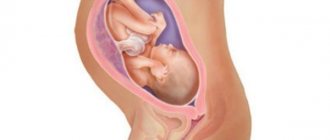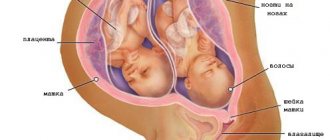Fetal development at 27 weeks of gestation
The baby's weight is already approaching one kilogram. On average, a fetus at the 27th week of its development weighs about 900 g and its height is 36 cm. Starting from last week and for the rest of its intrauterine life, the child will continue to grow actively. This is a natural process, which is explained by the production of growth hormone in his body - somatotropin, which became possible due to the development of the anterior lobe of the pituitary gland.
The endocrine glands begin to work. The pancreas produces insulin, and the thyroid gland produces thyroxine, calcitonin and triiodothyronine. These hormones are necessary for the normal course of metabolic processes and for the development of the child’s body as a whole.
The respiratory system continues to improve. Alveoli and bronchial passages actively develop in the lungs. Starting this week, a surfactant appears in them, which will allow them not to stick together. The lungs are not yet ready for independent breathing, however, if the baby is born at 27 weeks, he will have a fairly high chance of survival. Naturally, it will not be possible to do without specialized equipment and without the help of doctors.
The baby's immunity is now in the stage of active development in order to provide it with the necessary protection after the birth of the child.
Every day the baby becomes more and more like a newborn. His eyes begin to open, his ears protrude, his fingertips acquire soft nails, his eyelashes and eyebrows become thicker, and hair grows on his head. The skin is still covered with wrinkles, because the baby’s body is constantly in contact with water. Fat is actively accumulating under the dermis, which will ensure adequate thermoregulation of the baby after birth. The skin itself is no longer as red as before; little by little it begins to lighten.
The child reacts to sound and light, smiles and frowns, and fingers the umbilical cord. If the baby is born at 27 weeks, he will already be able to distinguish not only tastes, but also smells.
The fetus no longer spends all its time asleep; it periodically wakes up, but for a very short period of time. During the waking period, the baby actively tumbles, swims, kicks, and stretches. This allows him to gain muscle strength, so the woman clearly feels when the child inside her has woken up. Often, watching her belly, the expectant mother notices its rhythmic twitching - this is the baby hiccupping. Most often, hiccups do not last long and do not cause any discomfort in the child.
How long does a fetus sleep?
A pregnant woman notices over time that her baby has established his own routine. The fetus develops a personal rhythm of daily activity. In moments of wakefulness, the fetus moves, “studies” the uterine space surrounding it, gets acquainted with its own body (sucks its toes, heels, touches the umbilical cord), trains the muscles of the body and facial muscles (stretches, turns, smiles, frowns, yawns). In addition, the baby is already in the womb busy training organs that must “learn” to perform their functions before the baby is born. Namely: the child swallows and inhales amniotic fluid. This allows him to train the gastrointestinal, excretory and respiratory systems. From a certain time, the fetus listens to the sounds of the surrounding world, the mother’s voice and the noises of her body.
How long does a baby sleep in the womb?
All these actions take a lot of energy from the child! Therefore, periods of his lively wakefulness are replaced by periods of sleep. The duration of these periods can reach a total of sixteen to twenty hours.
Researchers who managed to take an electroencephalogram of the fetal brain found that a child’s sleep is divided into two phases (which are also typical for adults) - fast and slow. The fetal REM sleep phase takes up almost 50 percent of the time (while adult sleep is mostly “slow” sleep, with REM sleep accounting for only 20 percent).
So, the fetus sleeps a significant proportion of the time - most of the day for the baby is spent sleeping. The activity of the baby is closely interconnected with the lunar phases. As a rule, a healthy fetus perks up and becomes more active in the evening hours (namely between 21.00 and one in the morning). The child will retain these rhythms of sleep and activity for some time after birth.
Scientists conducted an experiment, the purpose of which was to find out how long the fetus maintains the regime that it established independently in the womb. For this purpose, mothers kept diaries, recording the mobility and rest of the fetus. After the birth of the children, it turned out that the baby sleeps at the same hours as in the mother’s belly.
It is known that if a mother keeps a diary of observations of the daily activity of the fetus, this helps her adapt to the needs of the child after his birth. After all, she already knows the hours at which the baby will sleep, as well as the hours at which he will need communication and care. Thus, the diary helped the mothers who took part in the study to plan their time more accurately.
The first movements of the fetus - when to expect the first movements, what is the normal intensity of movements.
What does the fetus feel - when the baby begins to hear, see, touch, taste and smell? And how can this be used for development before birth?
Pregnancy in pictures by week - find out how the fetus develops, as well as how your body changes.
Feel
As mentioned above, a woman may experience some discomfort due to the fact that the enlarged belly puts pressure on the intestines and stomach, as well as on the diaphragm. This causes digestive problems in the form of belching, heartburn and constipation. Sometimes there is a feeling of numbness in the upper and lower extremities.
To minimize discomfort, you need to follow simple recommendations:
- Spend time outdoors;
- Eat properly;
- Do not sit or stand for long periods of time;
- Do not lift heavy objects;
- Ventilate the room before going to bed.
These tips will also help you get rid of insomnia and headaches, and improve your mood.
Another leading sensation for a woman during pregnancy is fetal movements. From them you can understand what the baby is doing, as well as judge his well-being. It largely depends on the emotions that the woman herself experiences, so by all means you need to maintain a positive attitude, avoid stressful and conflict situations and rejoice in the fact that a new life is growing inside.
What happens to the uterus at 27 weeks of pregnancy
During an ultrasound, the doctor must examine the condition of the uterus. The thickness and height of its bottom and other important parameters are assessed. Normally, the uterus rises above the navel by 5-7 cm, and above the pubis by 26-28 cm.
Since the uterus is already quite large and heavy, it can cause some discomfort in a woman, for example, in choosing a sleeping position. If the body position is incorrect, there is a risk of pinching the vena cava. This, in turn, threatens increased dizziness and even loss of consciousness. Therefore, doctors strongly recommend that women at such a late stage of pregnancy refrain from resting on their backs, and when the expectant mother is sitting, her legs should not be crossed.
What happens to the belly at 27 weeks of pregnancy?
The size of the belly has increased, so now it protrudes noticeably from under clothes. It is possible that it is at the 27th week of pregnancy that a woman will first experience heartburn, belching, bloating, constipation and increased urination. All these “troubles” are quite understandable, since the grown uterus puts pressure on the internal organs both above and below.
By observing the movements of the baby inside the abdomen, quite often it is possible to understand where he is now turned and what he is doing - sleeping or awake. The child's activity increases precisely at the time when the woman goes to rest. To calm your baby, you can try singing him a lullaby while lightly stroking your belly. It would be good if the father was involved in this activity.
Special attention should be paid to the skin of the abdomen, because now it is very stretched and can peel off. Also at this time, the risk of stretch marks, which primarily appear on the abdomen, increases. To get rid of discomfort and reduce the risk of stretch marks, it is necessary to moisturize the skin. For this purpose, you can purchase special products or use vegetable oils.
The stomach should not hurt or become “stony”. If this happens, you need to consult a doctor.
How many movements should there be per day at 22-23 weeks?
First of all, congratulations on your next achievement: you can already feel your baby's movements. This is a joyful and very exciting moment in your life together. Suitable for the next stage of unity with the fetus and the realization that you will have a child. Unforgettable sensations and your heart skips a beat when you realize that your little arms and legs have already developed so much that they push you from the inside, showing that everything is okay. After all, it is by the frequency and strength of these movements that the mother understands what is happening to the baby: whether he is sleeping or awake, eating or playing. Over time, a routine appears and if a malfunction suddenly occurs, then the mother is on the alert, listens and persuades the baby to show that everything is in order, just an unplanned rest.
Of course, doctors are serious people, they need statistics, so it was calculated how much the baby moves on average at different stages of pregnancy. But every mother, reading these numbers, must remember that the data is statistically average! And you can’t equate yourself to this figure and be horrified every time the numbers don’t match. Everything is very individual. In addition, plump and tall women feel these movements to a lesser extent than lean and short women.
It seems to me that 200 is the total number of different movements of the fetus in the womb. And it’s not a fact that you feel everyone! A baby at this age already rubs his eyes, yawns, grabs his face, fingers the umbilical cord, runs and simply, swimming up to the walls of the uterus, pushes off from it, changing the trajectory of movement. It’s already big and there’s not much space, so with each passing week this kind of exercise becomes more and more noticeable for mom. At your stage of pregnancy, the baby makes from 20 to 60 kicks per day that are noticeable to you. The older you are, the stronger the movements, the greater the amplitude, the more often the blows (and often the more painful). I have two children, and I assure you, my heart sank more than once when the baby did not make itself known throughout the day. But when, on the contrary, the baby’s movements become very active, strong and erratic, sound the alarm, because... as a rule, this indicates dissatisfaction with the created conditions: little oxygen, too loud and disturbing sounds, strong odors, etc.
Now you are going through the most wonderful and easy period of pregnancy: toxicosis is behind you, your tummy has begun to grow, maternal feelings for this particular baby are appearing (even if there are older ones), dad can also touch that someone lives in the tummy. And at the same time, while putting on your shoes, you can still see your own feet and can independently bend down to pick up a fallen scarf. Enjoy your position and don't blindly follow the advice of friends and fashion magazines. Health to you and your baby.
Causes of pain at 27 weeks of pregnancy
At 27 weeks of pregnancy, a woman may periodically experience pain associated with her position.
Even if they are not strong and do not cause significant discomfort, you should understand the reasons for their occurrence:
- Abdominal pain that occurs after changing body position is most often explained by sprained ligaments that are preparing for the upcoming birth.
- Abdominal pain resembling indigestion is explained by training contractions. As a rule, such sensations are quite short-lived and are not accompanied by other symptoms.
- Pain in the spinal column, lower back and lower extremities is explained by their tension due to the increased load on the body. To reduce discomfort, you need to wear comfortable orthopedic shoes, rest more, massage your feet, and take foot baths in the evenings.
- Cramping pain in the legs indicates calcium deficiency in the body.
- Pain in the pubic and pelvic bones is explained by their slow divergence, which helps to expand the birth canal and make it easier for the child to pass through it.
However, there are also pains that cannot be tolerated under any circumstances. So, if severe pain occurs in the abdominal area, which is accompanied by the appearance of bloody discharge, it is necessary to call an ambulance.
Pain that occurs during urination requires a visit to the doctor. If they are accompanied by an increase in body temperature and a burning sensation in the genital tract, then you need to consult a specialist. These symptoms indicate a urinary tract infection.
Pain in the anal area and the appearance of blood on underwear indicate an exacerbation of hemorrhoids. This condition requires treatment, which must be prescribed by a doctor.
Intimate life at 27 weeks of pregnancy
Intimate life will be prohibited if a woman is at risk of premature labor. The fact is that during orgasm the uterus contracts, and this can be dangerous.
In the case when the pregnancy has a normal course, intimate life at 27 weeks can continue. However, caution will not be superfluous now. For example, it is necessary to avoid those poses that place excessive pressure on the abdomen. You should not practice deep penetrations or sudden movements. Otherwise, there are practically no restrictions.
Doctors unanimously recommend that women refrain from changing sexual partners during pregnancy. This will protect yourself and your child from various infectious diseases that can cause serious harm to health. Even in the case when a woman is confident in her new chosen one, the microflora of her vagina during pregnancy may “not accept him”, reacting with the development of inflammation.
Discharge at 27 weeks of pregnancy: norm and pathology
The most dangerous discharges are those containing blood. They can signal the onset of premature labor, placental abruption, or placenta previa. Therefore, if bleeding from the genital tract is detected, you must contact an ambulance.
Normally, the discharge should be light or with a slight milky tint. They may have a sour smell, but they should not contain any impurities or inclusions.
A deviation from the norm is considered to be discharge with the smell of fish, beer, yeast, etc. Concern should be shown when the discharge changes its natural color to yellow, green, earthy or brown. Most often, this indicates an infection that requires treatment.
Another frequent companion of a woman during pregnancy is candidiasis. It will be indicated by such signs as: the appearance of cheesy clots in the discharge, itching and burning in the genital area. It is imperative to get rid of thrush before childbirth, since the risk of infection of the child during its passage through the genital tract is extremely high.
You should definitely consult a doctor if amniotic fluid is detected. Sometimes they come out in copious streams, which indicates the onset of premature labor, and sometimes in small portions, which indicates thinning of the placenta. Both of these situations pose a threat to the health of the fetus and require hospitalization of the woman.
Sometimes at 27 weeks, discharge from the mammary glands appears. This is the first colostrum that can leave marks on the bra. To prevent the growth of bacteria, the breasts should be washed with warm water and gently blotted with a towel.
How often should the baby move?
How many times a day should a child move if everything is fine? A happy expectant mother, having learned about pregnancy, begins to listen to her condition. Often and for a long time, with her hand on her stomach, the woman tries to hear the child and catch his movements.
He begins to move actively at 7 weeks. But due to the small size of the fetus and sufficient space in the mother’s stomach, these movements are not felt. The baby's activity can only be observed through ultrasound.
The expectant mother can feel the first movements of the baby at 18-20 weeks. Moreover, if this is the first pregnancy, a woman can easily confuse the baby’s movements with the movement of gases through the intestines. Gradually, mommy will begin to distinguish between these two phenomena. The first movements can be felt even before this time. If the child is initially larger than age-appropriate babies, and the expectant mother, on the contrary, is very thin. In this case, you can feel the baby’s activity at 14-16 weeks of pregnancy. But the fact that at week 18 the baby should move at least 10 times is not true. At this stage, only multiparous women, that is, experienced mothers, can reliably understand when the baby moves in the uterus.
At 20 weeks of pregnancy, the baby should move several times a day in multiparous women. Primiparas at this stage do not always feel their baby. The sensations become more vivid from about 22 weeks. That is, the larger the fetus, the more noticeable its movements in the uterus.
The child develops a certain regime of rest and wakefulness. Usually it does not coincide with the regime of a pregnant woman. As soon as the mother decides to rest, the baby immediately “turns on” an active lifestyle. Some consider this fact a sign of the harmfulness and inconsistency of the future baby. But no! Everything is very simple to explain: when the mother leads an active lifestyle (moves around, works, etc.), the child rests thanks to her rocking and movements, like in a stroller. As soon as the mother goes to rest, the child receives a signal to stop movement, thanks to the greater flow of blood and oxygen along with it, and begins to become active.
We can say that when the mother is awake, the baby receives a little less oxygen (but still enough) than when she is resting.
How often should a child move during the day? The child must be active at least 10 times per day. But it is not at all necessary that movements should be observed regularly every hour. That is, even if the child does not move for 3 hours in a row, this is not a reason to be upset, he is simply resting. It is enough for a woman to lie down to rest, and the child will immediately wake up.
Starting from the third trimester of pregnancy, a gynecologist records the baby’s heartbeat (CTG), the cardiogram is recorded on paper and analyzed. High heart rates, as well as frequent and sudden changes, are considered normal for a fetus, while for an adult, the heartbeat should be smooth and without jumps. At low heart rates of the child, CTG is prescribed more often, and the pregnant woman can be placed under constant medical supervision. If ultrasound and CTG do not show any abnormalities, then any number of movements of the child are normal.
After the 36th week of pregnancy, the baby does not have enough space, he makes movements less often, but they are felt much stronger. Visually, you can notice protrusions of the abdomen in one place or another. The alarm should be sounded if a woman does not feel any movement for 12 hours in a row. Then you should immediately consult a doctor for an examination and to identify the reasons for the baby’s silence for such a long time.
Tests and studies at 27 weeks of pregnancy
Visits to the doctor should be regular and should not be violated. Now the woman will need to see her gynecologist more often - 2 times a month. At the appointment, the doctor will measure the abdominal circumference and blood pressure, determine the height of the uterine fundus, listen to the baby’s heartbeat and record the woman’s weight.
It will also be necessary to donate blood for general and clinical analysis, and blood to determine glucose levels. Urine is examined for protein. Sometimes cholesterol levels are elevated at 27 weeks. This is normal, since it is directly involved in the hormonal changes that occur in a woman’s body (the placenta needs cholesterol to produce progesterone).
Starting from the 27th week of pregnancy, a woman’s risk of developing late toxicosis increases. Its signs are: increased blood pressure, protein in the urine, severe swelling. That is why examinations by a doctor should be regular and tests scheduled.
If a woman is Rh negative, she will need to donate blood for Rh testing.
Why does the child move little?
Fetal movements are one of the most exciting experiences awaiting a pregnant woman. Many expectant mothers feel the full extent of their motherhood precisely at the moments of the baby’s first kicks. Movements not only give unique feelings and emotions, but also become a highly accurate indicator of the child’s health. From a certain period, doctors recommend that pregnant women monitor the number of movements per day, since an excessive or insufficient number may indicate any problems in the condition of the fetus.
When do baby's movements become noticeable?
Motor activity of the fetus first occurs in the eighth week of pregnancy, but during this period the embryo is still too small for its movements to be felt from the outside. The developing nervous system is responsible for the baby’s motor activity. Thanks to its activity, the fetal muscles begin to contract. We are not yet talking about coordinated movements. The baby’s movements are spontaneous and erratic, he floats freely in the amniotic fluid, which dampens the movements, so at such an early stage the expectant mother does not feel anything unusual. For the first time, a woman begins to feel the movements of her child at 20-22 weeks of pregnancy. If this is not the first pregnancy, the sensations come a couple of weeks earlier.
Don't be alarmed if you don't feel frequent movements at 20 weeks. At this stage, they do not say anything about the course of pregnancy: each woman has her own threshold of sensitivity. Until 24-25 weeks, movements may be insignificant.
For the first time, regular movements appear after 24-25 weeks of pregnancy. From this moment on, the expectant mother learns to recognize the movement language of the unborn child. Sooner or later she will notice that the fetus begins to react to changes in the mother’s emotional state. Out of joy or excitement, the baby may begin to move more actively, but may also calm down for a while.
What can cause movements to decrease?
Doctors advise expectant mothers to closely monitor the movements of the fetus, starting from the 28th week of pregnancy. The norm is considered to be at least ten movements per day, starting at 9:00 and ending at 21:00. Up to 28 weeks, the number of movements depends only on the woman’s individual sensitivity and other factors (for example, on the location of the placenta on the anterior or posterior wall of the uterus).
The child may well be less active if the mother is physically active. When walking or active activity, the child seems to be lulled to sleep, since walking creates the effect of a smooth rocking motion, and the amniotic fluid serves as a natural shock absorber. This cessation of physical activity is not a cause for concern.
A cause for concern may be a child's prolonged silence for 12 hours or more. If you have not felt a single movement for such a long period of time after 28 weeks, this may indicate serious fetal hypoxia that threatens its life. In this case, you must immediately consult a doctor and undergo an ultrasound examination and CTG to determine the child’s condition.
Contact your healthcare provider to provide you with the most commonly used tests to help you regularly count the number of fetal movements.
Do not be alarmed if the baby’s activity decreases after 32-33 weeks of pregnancy. The baby becomes cramped in the uterus, so the movements become more rare and less pronounced, but they should not disappear completely. The expectant mother is recommended to monitor the baby's activity daily and communicate with him in preparation for childbirth.
Ultrasound at 27 weeks of pregnancy
There is no need to undergo an ultrasound scan at 27 weeks of pregnancy unless there are special indications for this. Doctors can prescribe a test if they suspect a frozen pregnancy, if there are any threats to the fetus, for example, if a woman has suffered a serious illness, etc.
During an ultrasound, the doctor assesses the growth and development of the child, examines his internal organs and systems, and excludes disturbances in their functioning. The baby's heart normally makes about 140 beats per minute, and the number of respiratory movements is equal to 40. Of course, the baby is not breathing yet, because he is in the amniotic fluid. However, chest movements allow you to train the muscles and prepare them for life outside the womb.
At the same time, the doctor assesses the quantity and quality of amniotic fluid, the condition and degree of maturity of the placenta. If before this the woman did not know the sex of the child, then during the ultrasound the doctor will tell her the gender of the baby.
What worries the expectant mother of twins?
During this period, women expecting twins may experience spinal pain. Also, many are concerned about the problem of uterine tone, frequent urge to urinate, feeling of heartburn and non-labor contractions. By the way, the uterus and placenta only benefit from these training contractions.
Pregnant women with twins are sometimes at risk. In a twin pregnancy, the placenta may overlap the uterus. In this case, normal blood circulation is disrupted. Twins or twins stop receiving enough vital elements.
Do you feel prolonged pain in the lower abdomen? Are your amniotic fluid breaking? Call an ambulance immediately. Twins are usually eager to see the world. In 50 percent of cases, babies are born prematurely. But 7 months is no longer scary. Children are almost always born mature. Photos of bellies with twins.
Principles of proper nutrition
The basic principles of nutrition at 27 weeks of pregnancy remain the same:
- You need to eat food in small portions.
- Salt consumption should be kept to a minimum.
- Products must be of high quality and fresh.
- It is necessary to abandon the abundant inclusion of confectionery, baked goods, and sweets in the menu.
- The menu should be balanced in composition.
- For breakfast, it is best to eat cereal porridge, during lunch the emphasis should be on protein dishes, and dinner should be light and must contain foods rich in calcium (cottage cheese, kefir, yogurt, etc.).
- Every day you need to eat fresh vegetables and fruits.
- For drinks, preference should be given to plain water. You are also allowed to drink compotes, fruit drinks, and fresh juices.
Recommendations for mothers
It will not be difficult for specialists to determine the sex of the fetus at 27 weeks
Due to the increasing volume and weight of the uterus, the mother needs to constantly monitor the position of her body. When sleeping, it is recommended to sleep on your side, preferably on your left. Use a pregnancy pillow or place small pillows under your stomach or back to relieve muscle tension. If you are prone to varicose veins, wear compression stockings at all times to protect the veins from stretching. To reduce the load on the muscles and ligaments of the abdomen and spine, wear a prenatal bandage.
You now need only positive emotions, because your baby’s well-being largely depends on your mood. It is known that blood circulation is impaired during stress, so there is no need to be nervous.
It is recommended to avoid excessive heat exposure. Do not spend time under the scorching sun, avoid visiting the bathhouse, sauna, or taking a hot bath. High temperatures relax the cervix and can trigger premature labor.
Trips
Before going to the sea, get your doctor's approval
If you are planning a vacation, do not go far; postpone the trip until after childbirth. Air travel is now undesirable - due to pressure changes, premature labor may begin. If you need to fly, get a certificate from your doctor indicating the duration of your pregnancy and permission to fly. Without this document, you may not be allowed on board the airliner. Long trips by car or bus are now also undesirable due to the need to be in the same body position for a long time. This can impair blood circulation and lead to poor health. The optimal mode of transport now is rail.
Sex
If there are no contraindications, sex is not prohibited
If the condition of the expectant mother and baby is stable, and the doctor does not prohibit intimate life, there is no reason to refuse sex. Some mothers even note that the baby becomes quiet during intercourse, as if trying not to interfere with parental privacy. After sexual intercourse, the baby may, on the contrary, be too active under the influence of the happiness hormone transmitted from the mother. It is also believed that sperm has a beneficial effect on the cervix. It is recommended not to make sudden movements during lovemaking, to choose positions that do not put pressure on the stomach and do not require physical stress from the woman. If your spouse is afraid of harming the baby, explain to him that the fetus is reliably protected from mechanical stress in the walls of the uterus.
Contraindications for sex are:
- threat of premature birth;
- short cervix;
- multiple pregnancy;
- low placenta previa.
Physical activity
There are sets of exercises designed specifically for pregnant women.
All types of physical activity are allowed, excluding excessive muscle tension, aerobic exercise, heavy lifting, and sudden movements. Breathing exercises are useful for the expectant mother, improving oxygen exchange between her body and the fetus. It is recommended to take more walks in the forested area at a calm pace.
Swimming, gymnastics or yoga for pregnant women will help strengthen muscles and maintain body tone. To ease the labor process and speed up recovery afterward, perform Kegel exercises designed to strengthen the muscles of the perineum.
Nutrition
Increase your protein and calcium intake
Eating healthy, small meals can help relieve heartburn and solve constipation. Choose fresh ingredients and cook them gently. Fresh vegetables and fruits and cereals will improve intestinal motility. During an attack of heartburn, drink milk. Minimize the consumption of allergenic products - cocoa, chocolate, citrus fruits, because the baby’s immune system has already begun to function and an allergy to these products may develop.
Avoiding rapid weight gain will help avoid high-calorie and carbohydrate foods. Choose a worthy alternative to such products - replace sweets with dried fruits, for example. Provide a balanced diet, eat daily:
- porridge;
- soups;
- dairy products;
- fish or meat dishes;
- vegetables and fruits.
If swelling occurs, your doctor may recommend limiting your fluid intake and avoiding salty foods. If you really want to try something harmful but tasty, don’t torment yourself - eat it, but in reasonable quantities, and as an exception to the rule.










